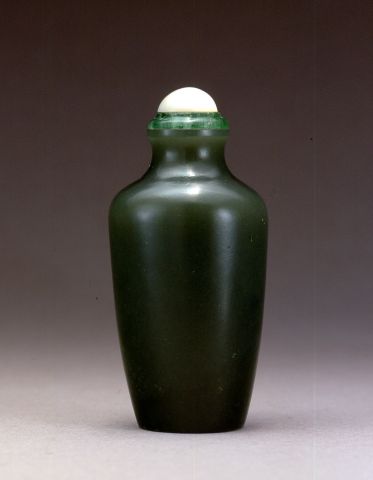
Bottle ID: 374
SAGE-GREEN, VASE
Date: 1736-1799
Height: 56 mm
Nephrite of translucent, even, sage-green color, well hollowed, of tapering meiping (‘prunus blossom vase’) form with shoulders sloping to a flared mouth and at the base to a concave circular footrim.
Imperial, attributed to the Palace Workshops, Beijing.
Similar Examples:
Crane Collection no.s 197 and 632
Moss, Hugh, Victor Graham and Ka Bo Tsang. A Treasury of Chinese Snuff Bottles - The Mary and George Bloch Collection, 1995, Vol. 1, pp. 202-203, no. 82.
Provenance:
Hugh Moss [HK] Ltd.
Published:
JICSBS, Spring 2000, p. 9, fig. 8
JICSBS, Winter 1999, pp. 8-10, figs. 1, 5, 6, 7 and 8
In jade, hardstone and glass bottles, the minaiture vase form seemed to be a favored one at the Imperial Court. Often the outer surface was carved in low relief with classic archaic patterns and motifs such as the taotie mask. The opaque sage-green color of nephrite was very rare and was used in the Imperial Workshops for small carvings and the occasional snuff bottle. The tapered vase form for a bottle, unless very well hollowed, lacks a translucency which is usually desirable in a snuff bottle. This shape may therefore have been a conscious choice for this particular material with its tendency towards opacity. In the Court, vases of this form in jade often held ruyi-scepters; together symbolic of peace and fulfillment of all wishes, since the word for vase is 'ping' which is a pun on 'peace' ('ping'an').
< Back to full list
 English
English 中文
中文